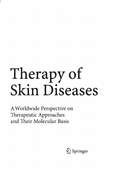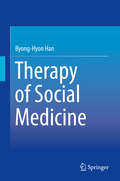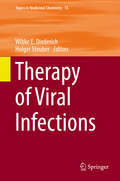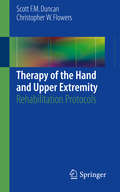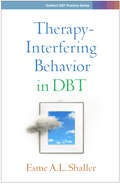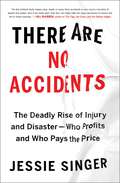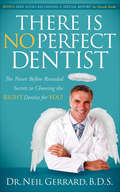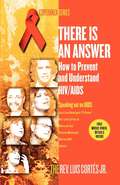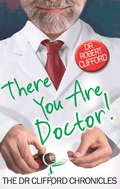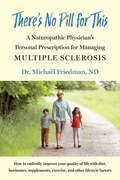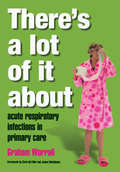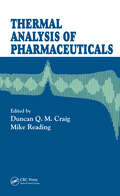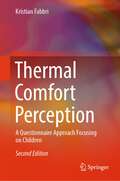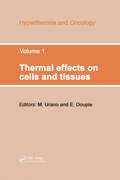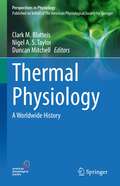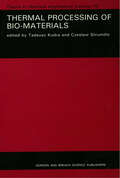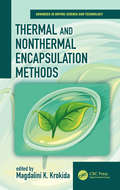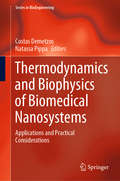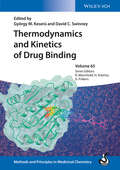- Table View
- List View
Therapy of Skin Diseases
by Thomas Krieg David R. Bickers Yoshiki MiyachiBased on the understanding of the molecular basis of skin diseases, this truly international book supports the reader to understand the mode of action of new and established therapies. Thus, by explaining the molecular pathology with its applications for therapy, it provides the reader with an up-to-date knowledge of the therapy of skin disease and helps to understand ongoing and new developments in the field. Written and edited by international and renowned dermatology experts from Europe, America and Asia, it also includes regional concepts of therapies. The reader-friendly structure allows the reader to pick up the information quickly; for example, each chapter highlights practical hints for indications and applications. This lavishly illustrated book will support the reader to choose the most appropriate therapy for the patient and to reach a better treatment outcome. It will be an indispensable resource for dermatologists in university departments as well as in clinical practice.
Therapy of Social Medicine
by Byong-Hyon HanThis book introduces novel and groundbreaking theories on social medicine, social medicine therapy and pharmacogelotology. Aimed at improving the global health care system in terms of cost-effectiveness and efficiency, the research included in this book represents a paradigm shift from traditional drugs to social medicine. Tracing the history of social medicine, from Natural Healing Power (NHP), Oriental Medicine's vitalism, to Homeostasis (Natural Healing Strength) and Reciprocity (Social Healing Strength), the book first focuses on laying the theoretical foundations. It then highlights how social medicine can be specialized into various social medicine therapies (i. e. , aromatherapy, stone therapy, diet therapy, exercise therapy, light therapy, etc. ), just like stem cells. This is followed by arguments that 21st century pharmacy should be a harmonious system where the replacement of traditional drug products (i. e. , herbal, chemical, and biological products) with new social medicine takes precedence. To that end, the author focuses on the '4+2 system' with 4 representing diet, body, stress, and facial-image control, and 2 representing the complementary and alternative medical methods of evacuation(-) and filling(+). In the context of pharmacogelotology, the book then goes on to present findings on theories of laughter and laughter therapy practices, which are systematically examined and described in detail. Finally, it calls for the development of social-medicine structures by governments that aim to help local authorities use their resources effectively, and for local governments to establish the long-term planning on social-medicine therapy for healthy ageing.
Therapy of Viral Infections
by Wibke E. Diederich Holger SteuberMedicinal chemistry is both science and art. The science of medicinal chemistry offers mankind one of its best hopes for improving the quality of life. The art of medicinal chemistry continues to challenge its practitioners with the need for both intuition and experience to discover new drugs. Hence sharing the experience of drug research is uniquely beneficial to the field of medicinal chemistry. Drug research requires interdisciplinary team-work at the interface between chemistry, biology and medicine. Therefore, the topic-related series Topics in Medicinal Chemistry covers all relevant aspects of drug research, e. g. pathobiochemistry of diseases, identification and validation of (emerging) drug targets, structural biology, drugability of targets, drug design approaches, chemogenomics, synthetic chemistry including combinatorial methods, bioorganic chemistry, natural compounds, high-throughput screening, pharmacological in vitro and in vivo investigations, drug-receptor interactions on the molecular level, structure-activity relationships, drug absorption, distribution, metabolism, elimination, toxicology and pharmacogenomics. In general, special volumes are edited by well known guest editors.
Therapy of the Hand and Upper Extremity
by Scott F. M. Duncan Christopher W. FlowersPresenting over 100 rehabilitation protocols for the hand and upper extremity in an easy-to-use, step-by-step format, this practical reference provides surgeons and therapists alike with a go-to source for the therapy technique or strategy appropriate for their patients. Covering injuries from the shoulder, elbow, wrist, hand and fingers, each protocol includes bullet-pointed steps in daily or weekly increments following the injury or surgery and are inherently adaptable to the specific surgical intervention or rehabilitation requirement. Procedures following arthroplasty, extensor and flexor tendon injuries, fractures and dislocations, ligament and soft tissue injures, and nerve compression syndromes are among the many and multifaceted therapies presented. This book will be an invaluable resource for the orthopedic surgeon, hand surgeon, physical therapist, occupational therapist, hand therapist and any active clinician treating injuries to the hand and upper extremity.
Therapy, Culture and Spirituality
by Greg Nolan William WestThis edited collection addresses how therapy can engage with issues of race, culture, religion and spirituality. It is a response to the need for practitioners to further their understanding and skills base in developing ways of appropriately responding to the interconnectivity of these evolving issues.
Therapy-Interfering Behavior in DBT (Guilford DBT Practice Series)
by Esme A. ShallerTherapy-interfering behavior (TIB) is a key treatment target in dialectical behavior therapy (DBT), second only to suicidal thinking and self-harm. This wise, engaging book gives clinicians everything they need to assess, understand, and address TIB both in clients and in themselves. Therapists learn how to orient clients to TIB and work with it effectively whenever it shows up, using a combination of validation, contingency management, and dialectics. Packed with clinical examples, dialogues, and practical tips, the book discusses the full range of DBT contexts, from individual therapy to skills class, phone coaching, and consultation teams.
TherapyEd's National Occupational Therapy Certification Exam Review And Study Guide
by Rita P. Fleming-CastaldyThe NBCOT is a high stakes exam and TherapyEd new, 8th edition National Occupational Therapy Certification Exam Review and Study Guide is the ONLY book which combines comprehensive content review with challenging practice questions to help you pass the exam. The content review helps you know what to study and the practice exams give you feedback so you understand how you did, what your strengths and weaknesses are, and how to better prepare for the exam. This book now comes with an online access code in the back of the book for the exams in place of a USB drive.
There Are No Accidents: The Deadly Rise of Injury and Disaster—Who Profits and Who Pays the Price
by Jessie SingerA journalist recounts the surprising history of accidents and reveals how they&’ve come to define all that&’s wrong with America.We hear it all the time: &“Sorry, it was just an accident.&” And we&’ve been deeply conditioned to just accept that explanation and move on. But as Jessie Singer argues convincingly: There are no such things as accidents. The vast majority of mishaps are not random but predictable and preventable. Singer uncovers just how the term &“accident&” itself protects those in power and leaves the most vulnerable in harm&’s way, preventing investigations, pushing off debts, blaming the victims, diluting anger, and even sparking empathy for the perpetrators. As the rate of accidental death skyrockets in America, the poor and people of color end up bearing the brunt of the violence and blame, while the powerful use the excuse of the &“accident&” to avoid consequences for their actions. Born of the death of her best friend, and the killer who insisted it was an accident, this book is a moving investigation of the sort of tragedies that are all too common, and all too commonly ignored. In this revelatory book, Singer tracks accidental death in America from turn of the century factories and coal mines to today&’s urban highways, rural hospitals, and Superfund sites. Drawing connections between traffic accidents, accidental opioid overdoses, and accidental oil spills, Singer proves that what we call accidents are hardly random. Rather, who lives and dies by an accident in America is defined by money and power. She also presents a variety of actions we can take as individuals and as a society to stem the tide of &“accidents&”—saving lives and holding the guilty to account.
There Is No Perfect Dentist: The Never Before Revealed Secrets to Choosing the Right Dentist for You!
by Dr. Neil GerrardDon&’t brush off your dental health! Get tips on how to find the dentist who checks off all your boxes—for regular cleanings or special procedures. This book helps you with one of the most important health choices you will ever face. Whether you have an existing dentist who does not offer the type of care you require or whether you are looking to make a change, you want to choose a dentist you can trust, and who has your and your family&’s best interests at heart. With the myriad choices out there, it&’s hard to narrow down your options—even with personal recommendations and online reviews. There Is No Perfect Dentist gives you the knowledge to make an informed choice. It discusses where to look, what to expect from your first visit, the role of dental specialists and the dental team, how to deal with problems and disagreements, and even how to overcome dentophobia (the fear of dentists). Sink your teeth into There Is No Perfect Dentist and be happy with your smile!
There Is an Answer
by Luis CortesHIV/AIDS is a scary subject. Not only can it destroy a body but it can also destroy a family, friendships, and even a community. Nobody likes to talk about it, but ignoring the problem won't make it go away. In fact, what you don't know can hurt you and somebody else. The only way we can overcome this disease is through education, precaution, and proper treatment, because nobody is immune. The Reverend Luis Cortés teaches you how to understand the virus and the disease. Prevention is the best approach, but contracting HIV is no longer a death sentence. There are now a variety of treatment choices available and people are living with it, not dying from it. Above all, whether you or someone you know has HIV/AIDS, or you simply want to educate yourself, realize this: There is an answer.
There Is an Answer
by Rev Luis CortesHIV/AIDS is a scary subject. Not only can it destroy a body but it can also destroy a family, friendships, and even a community. Nobody likes to talk about it, but ignoring the problem won't make it go away. In fact, what you don't know can hurt you and somebody else. The only way we can overcome this disease is through education, precaution, and proper treatment, because nobody is immune. The Reverend Luis Cortés teaches you how to understand the virus and the disease. Prevention is the best approach, but contracting HIV is no longer a death sentence. There are now a variety of treatment choices available and people are living with it, not dying from it. Above all, whether you or someone you know has HIV/AIDS, or you simply want to educate yourself, realize this: There is an answer.
There Is an Answer
by Rev Luis CortesHIV/AIDS is a scary subject. Not only can it destroy a body but it can also destroy a family, friendships, and even a community. Nobody likes to talk about it, but ignoring the problem won't make it go away. In fact, what you don't know can hurt you and somebody else. The only way we can overcome this disease is through education, precaution, and proper treatment, because nobody is immune. The Reverend Luis Cortés teaches you how to understand the virus and the disease. Prevention is the best approach, but contracting HIV is no longer a death sentence. There are now a variety of treatment choices available and people are living with it, not dying from it. Above all, whether you or someone you know has HIV/AIDS, or you simply want to educate yourself, realize this: There is an answer.
There You Are, Doctor!
by Robert CliffordAs charming as he is entertaining, Dr Robert Clifford dispenses a delightful dose of hilarious anecdotes, colourful portraits of patients, family and friends, tempered with heartwarming tales of human courage and tragedy.There's the eccentric hermit Hamish Richardson; the stubborn Romany Zackovitch Hebden; Miss Peabody, the elderly spinster ever hopeful of a pools win; and William Jessop, the blind man whose handicap obviously isn't a handicap! As well as stories from his Tadchester surgery, Dr Robert Clifford tells of his son's accident on Sark and there are more fishy tales with water bailiff John Denton and a sparkling of delightful descriptions of holidays at home and abroad.Doctor, family man, humourist, philosopher and counsellor, Dr Robert Clifford's stories are a tonic for us all.
There You Are, Doctor! (The Dr Clifford Chronicles)
by Dr Robert CliffordAs charming as he is entertaining, Dr Robert Clifford dispenses a delightful dose of hilarious anecdotes, colourful portraits of patients, family and friends, tempered with heartwarming tales of human courage and tragedy.There's the eccentric hermit Hamish Richardson; the stubborn Romany Zackovitch Hebden; Miss Peabody, the elderly spinster ever hopeful of a pools win; and William Jessop, the blind man whose handicap obviously isn't a handicap! As well as stories from his Tadchester surgery, Dr Robert Clifford tells of his son's accident on Sark and there are more fishy tales with water bailiff John Denton and a sparkling of delightful descriptions of holidays at home and abroad.Doctor, family man, humourist, philosopher and counsellor, Dr Robert Clifford's stories are a tonic for us all.
There is a Season (Cheney and Shiloah: The Inheritance #3)
by Gilbert Morris Lynn MorrisA. holiday in the warm environs of Florida comes as an answer to prayer to Cheney and Shiloh Irons- Winslow. New York City is experiencing a brutal winter, and the demands of Cheney's medical practice have nearly overwhelmed her. So they set sail on Shiloh's clipper, Locke's Day Dream, and head to Sangria House, a gracious mansion in old St. Augustine. Arriving wet and cold in the middle of a rainstorm, they find the house locked and deserted; obviously no preparations have been made to receive them. But they decide to make the best of it and settle in with good grace and humor in anticipation of a relaxing time together.... Then they make a horrifying discovery, and Cheney and Shiloh immediately suspect foul play. Sangria House was supposed to be a place of rest and renewal. Instead, it seems to be harboring disturbing secrets. SOLVING THE CRIME, WITHOUT FALLING VICTIM THEMSELVES, WILL REQUIRE ALL THE RESOURCES THEY CAN MUSTER.
There's No Pill for This: A Naturopathic Physician's Personal Prescription for Managing Multiple Sclerosis
by Michaël Friedman"I truly recommend There&’s No Pill for This because it contains the wisdom of a health care professional who also has the experience of being a patient."—Bernie Siegel, MD, author of No Endings, Only Beginnings and Love, Medicine & MiraclesFrom a doctor living with MS: how to radically improve your quality of life with diet, hormones, supplements, exercise, and other lifestyle adjustmentsMost of us take for granted the little things in life—like walking out to the mailbox, socializing with friends, or enjoying a mug of hot coffee. But what if each daily activity required intensive planning and effort? That&’s what living with multiple sclerosis is like, and author Michaël Friedman knows this from first-hand experience.Since his diagnosis of multiple sclerosis a decade ago, Dr. Friedman has been searching for a cure for the disease. After years of research, he realized that he had some of the answers right in his naturopathic medicine toolbox, and others, surprisingly, lay in the realm of conventional medicine. There&’s No Pill for This tells his story and offers treatment advice and hope to those who suffer from MS. He does not promise a miracle cure but instead provides the personal prescriptions he follows that are delaying the disease process and radically improving his quality of life, including dietary measures and supplements to support a healthy microbiome and hormone therapies that can reduce neuroinflammation and possibly promote neurorestoration. Dr. Friedman presents a daily protocol for MS patients, including diet, supplement, detoxification, and hormone strategies; mindfulness therapy; physical therapy; and a wide range of beneficial lifestyle adjustments related to exercise, sleep routines, time management, stress management, and more. He also offers special advice for supporting healthy bladder and bowel function and improving oxygen supply.In the book&’s conclusion, Dr. Friedman reflects on what this complicated chronic disease has taught him, and continues to teach him, about the value of humility and about what is truly important in life.
There's a Lot of it About: v. 2, Private Life
by Chris Del Mar Graham Worrall Sir Liam DonaldsonThis book contains forewords by Chris Del Mar and James Hutchinson respectively - Dean, Faculty of Health Sciences and Medicine, Bond University, Australia; Chief of Infectious Diseases Control, Memorial University of Newfoundland, Canada. Acute respiratory infections make up a quarter of all primary care consultations. This book is the ideal quick reference and teaching aid. In presenting best evidence on the epidemiology, causes and management of the most common acute respiratory infections, this book gathers together a wealth of previously scattered original research and information and offers solutions for practical application. It is concise, clear and easy to use. Primary care professionals, including doctors, nurses and health visitors will find it invaluable, as will general practitioners in training. 'There is much more to these diseases than most of us realise. It will not take you long to find fascinating and useful material here. It makes for a very interesting read. The evidence about management, as well as diagnosis, is very important. Acute respiratory infection is one of the famously important areas in which mistaken beliefs by not only our patients, but also us doctors, of the benefits of antibiotics makes to the contribution of bacterial resistance. Graham Worrall has highlighted new forms of treatment we often forget when we reach for the pad to write another 'safety' prescription for antibiotic. There is a wealth of information here.' - Chris Del Mar, in his Foreword. 'An objective, thoughtful treatment of a subject that accounts for a large part of a primary care physician's working life but inexplicably little of his or her training. Thorough evaluation of the literature, often exposing huge gaps in the study of these extremely common conditions, will serve as an impetus for study and a guide to rational decision-making. The straightforward approach with excellent practical distillations of the evidence and resulting recommendations is perfect for the busy physician or busy student. As someone who teaches medical students about infections I have longed for a concise resource to support my efforts at encouraging prudent antibiotic prescription for respiratory tract infections. I long no more.' - James Hutchinson, in his Foreword.
Thermal Analysis of Pharmaceuticals
by Duncan Q. M. CraigAs a result of the Process Analytical Technologies (PAT) initiative launched by the U.S. Food and Drug Administration (FDA), analytical development is receiving more attention within the pharmaceutical industry. Illustrating the importance of analytical methodologies, Thermal Analysis of Pharmaceuticals presents reliable and versatile charac
Thermal Comfort Perception: A Questionnaire Approach Focusing on Children (Springerbriefs In Applied Sciences And Technology Ser.)
by Kristian FabbriThis book offers a comprehensive exploration of children's understanding and experiences of thermal comfort. The book provides a methodology for evaluating comfort that takes into account the unique perspectives of children. The first part of the book provides an overview of the history of thermal comfort, the human body and environmental parameters, and common thermal comfort indexes. It also offers guidelines for creating questionnaires that accurately assess children's perceptions of indoor thermal comfort. The book then delves into children's understanding of the concepts of comfort and energy, as well as the factors that influence their perception of these concepts. It addresses the psychological and pedagogical aspects of thermal comfort judgment, as well as the architectural and environmental characteristics that contribute to children's perceptions of comfort. First published as Indoor Thermal Comfort Perception, this updated edition also includes new sections on architecture and sensitivity, exploring the impact of classroom spaces on learning, and outdoor education and thermal comfort outdoors, based on qualitative research. These additions provide valuable insights for future studies on these topics. While physical parameter measurements and comfort indexes are useful in thermal comfort, the book emphasizes the importance of ergonomic assessments in the form of questionnaires, which offer unique insights into children's experiences. The book fills a critical gap in understanding children's perceptions of thermal comfort and is essential reading for HVAC engineers, architects, environmental psychologists, and researchers in the medical and cognitive fields.
Thermal Effects on Cells and Tissues
by M. Urano E. DoupleVolume 1 of Thermal Effects on Cells and Tissues covers Hyperthermia and Oncology. This is a collection of eight essays.
Thermal Physiology: A Worldwide History (Perspectives in Physiology)
by Duncan Mitchell Clark M. Blatteis Nigel A. S. TaylorThis edited volume records the critical historical developments in thermal physiology and makes them accessible to new and senior thermal biologists and scientists in related fields. Readers will discover how the discipline developed all over the world. Contributions from 14 different countries recollect all prominent discoveries, starting in the 18th century. Like other volumes of the Perspectives in Physiology series, this book reveals the people behind these discoveries. The authors also set the scenes in which the research was conducted in their countries. From geopolitical frameworks to new technologies and extraordinary personalities - this volume shows that scientific progress is influenced by many, often unforeseeable, factors. The history of thermal physiology not only is a story about individual outstanding scientists, but a testament for open collaboration and international comradery.
Thermal Processing of Bio-Materials (Topics in Chemical Engineering)
by Tadeusz Kudra Czeslaw StrumilloAs a result of developments in biotechnology, bioengineering, and related sciences, processing of bio-materials and bioproducts has become an area of strategic importance. Written in a textbook style, this book attempts to bring together both the theory and practice of thermal processing of bio-materials. The authors describe the principal techniques such as freezing, chilling, membrane concentration, evaporation, drying, and sterilization and their own research experiences, including degradation of thermo and xerolabile bio- products.
Thermal and Nonthermal Encapsulation Methods (Advances in Drying Science and Technology)
by Magdalini KrokidaEncapsulation is a topic of interest across a wide range of scientific and industrial areas, from pharmaceutics to food and agriculture, for the protection and controlled release of various substances during transportation, storage, and consumption. Since encapsulated materials can be protected from external conditions, encapsulation enhances their stability and maintains their viability. This book offers a comprehensive review of conventional and modern methods for encapsulation. It covers various thermal and nonthermal encapsulation methods applied across a number of industries, including freeze drying, spray drying, spray chilling and spray cooling, electrospinning/electrospraying, osmotic dehydration, extrusion, air-suspension coating, pan coating, and vacuum drying. The book presents basic fundamentals, principles, and applications of each method, enabling the reader to gain extended knowledge. The choice of the most suitable encapsulation technique is based on the raw materials, the required size, and the desirable characteristics of the final products.
Thermodynamics and Biophysics of Biomedical Nanosystems: Applications and Practical Considerations (Series in BioEngineering)
by Costas Demetzos Natassa PippaThis book highlights the recent advances of thermodynamics and biophysics in drug delivery nanosystems and in biomedical nanodevices. The up-to-date book provides an in-depth knowledge of bio-inspired nanotechnological systems for pharmaceutical applications. Biophysics and thermodynamics, supported by mathematics, are the locomotive by which the drug transportation and the targeting processes will be achieved under the light of the modern pharmacotherapy. They are considered as scientific tools that promote the understanding of physicochemical and thermotropic functionality and behavior of artificial cell membranes and structures like nanoparticulate systems. Therefore, this book focusses on new aspects of biophysics and thermodynamics as important elements for evaluating biomedical nanosystems, and it correlates their physicochemical, biophysical and thermodynamical behaviour with those of a living organism.In 2018, Prof. Demetzos was honored with an award by the Order of Sciences of the Academy of Athens for his scientific contribution in Pharmaceutical Nanotechnology.
Thermodynamics and Kinetics of Drug Binding
by Gy Rgy Keser David SwinneyThis practical reference for medicinal and pharmaceutical chemists combines the theoretical background with modern methods as well as applications from recent lead finding and optimization projects. Divided into two parts on the thermodynamics and kinetics of drug-receptor interaction, the text provides the conceptual and methodological basis for characterizing binding mechanisms for drugs and other bioactive molecules. It covers all currently used methods, from experimental approaches, such as ITC or SPR, right up to the latest computational methods. Case studies of real-life lead or drug development projects are also included so readers can apply the methods learned to their own projects. Finally, the benefits of a thorough binding mode analysis for any drug development project are summarized in an outlook chapter written by the editors.
